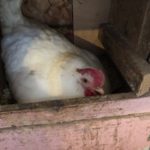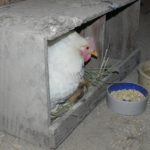We were surprised when one of our California White hens started acting strangely. She puffed up her feathers, clucked in an unusual tone, and spent hours patiently sitting in a nest box. But. we know she’s not sick. She’s broody and wants to be a mom.
We are not surprised when one of our large brown egg laying hens gets broody. Some breeds have a very strong maternal instinct and often show the maternal instinct. But California Whites are a hybrid of the white egg laying Leghorn breed, which rarely goes broody. In years of chicken keeping, this is the first time a white egg layer has shown a maternal instinct.
When one of our hens goes broody we do one of two things.
Discourage her:
Sometimes a hen goes broody at the wrong time, like December. Since the incubation time for a chicken egg is 21 days,
Since the incubation time for a chicken egg is 21 days, chicks hatching when the January temperatures may be 25 below zero isn’t a good idea. Also, we don’t have a rooster, so all the eggs are hens lay are infertile. Sometimes we discourage a broody hen because we don’t need more chicks.
To discourage a broody hen we move her to a separate coop where she’s alone and there is no nest box. We give her plenty of room and lots of good food and water. Often, she’ll shake the broody habit in a few days and we return her to the main coop.
Encourage her:
The brooding process is fascinating. If a hen goes broody in spring when chicks will hatch during warm weather and we want some more chicks, we’ll encourage her. We move her to her own small coop where she’s away from the other hens, give her a secure nest box, and put eight to 12 fertile eggs under her. If we don’t have a rooster, we’ll swap eggs with a nearby family who does or order fertile eggs online. She’ll sit patiently until the chicks hatch, and then the fun begins. The new mom will lead her babies around the coop, talking to them in chicken language. She’ll show them how to find food and keep them warm by letting them burrow into her feathers. Many hens are ideal mothers that teach and protect their babies. It’s a natural process, fun to watch, and is one of the joys of keeping chickens.



